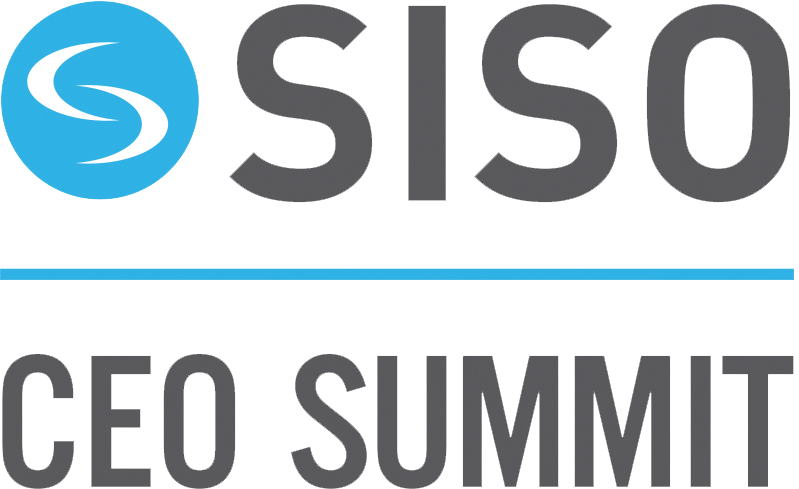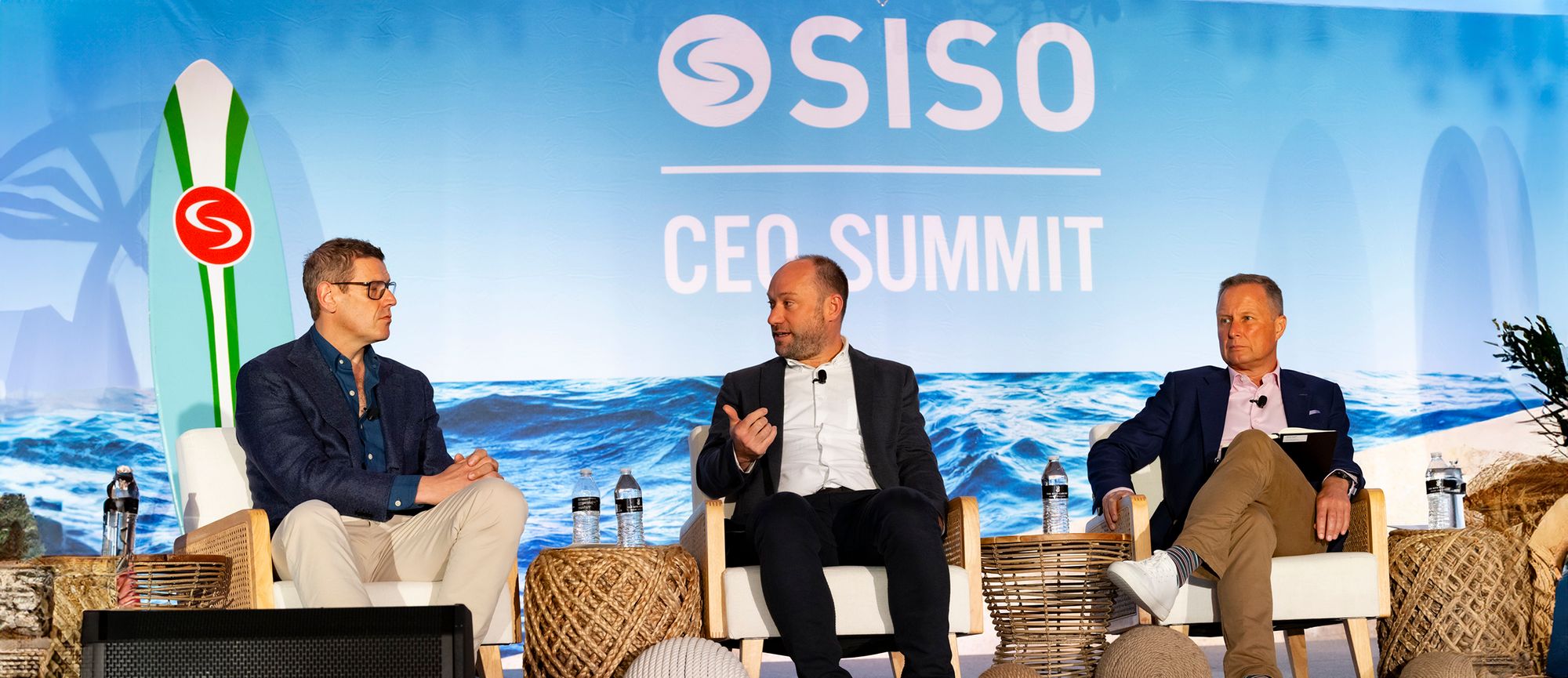CEO Panel: Beyond Recovery with Lisa Hannant, CEO, Clarion Events, Fernando Fischer, President, RX Americas, Hervé Sedky, CEO, Emerald and Nancy Walsh, President, North America Informa Markets and Mary Larkin, President, Diversified Communications as moderator.
The CEOs agreed on many of the same pressing issues as the industry moves beyond COVID. This included: working harder to prove value, containing increased exhibitor costs, diversifying their workforces and customers, and using digital judiciously in a way to help the customer journey to save time, make better connections, and enhance the experience.
The idea of proving value and dealing with cost increases came up repeatedly throughout the panel discussion. Bundling digital tools to help onsite connections, bringing in content to help make shows more of a 365 experience, and having real, consultative conversations with clients were all mentioned, along with trying to cut costs where they can.
Lisa Hannant said, “We are all consumers, and the expectation is for a normal consumer experience as an exhibitor or visitor.” Fischer concurred and said that it’s about providing and measuring client “micro-journeys” to provide an enhanced onsite experience.
And talent? The panel was mixed about a return to the office. Fischer summed it up best, “Why do we want our employees back in the office full-time? If they’re going to sit on zoom calls all day long, they may as well be at home. We need to be intentional with their time when they are there.” Sedky added, “We hold more intentional gatherings around our shows and have noticed our clients are doing the same thing.”
Show Me the Money (Supply)
Dr. Anirban Basu, MPP, MA, JD, Ph.D. from the Sage Policy Group provided an economic update and partial forecast, which is mixed. The current labor market is strong, and money is getting more expensive. That said, he sees weakening growth due to corporations pulling back on employment and expenses and thinks we’ll see the unemployment rate rise to 4.0% this summer/fall, along with a mild but protracted recession to 2024.
DE&I: How Diversity, Equity & Inclusion Can Radically Transform the Events Industry
Meera Somji and Andrew Carney, Co-Founders of Clusivity provided DE&I research into the top 22 companies in the exhibition/events business.
- 23% of leadership positions on boards are comprised of Caucasian women, up from 15% in 2020.
- One percent are minoritized ethnic men.
- Zero percent are minoritized ethnic women.
Their conclusions: Having a more diverse composition of top leadership will help attract and retain a more diverse employee base. Other concrete suggestions included: running inclusive events, zero harassment tolerance policies while equipping your teams with the right tools and training, creating diverse speaker panels (not about DE&I), and attracting new attendee groups to your shows.
The Show/Event/Community of Tomorrow: What are the customers looking for today in their b2b events?
Robyn Duda, Event Strategist & Experience Designer, Robyn Duda Creative LLC, Nancy Mastroianni, Head of Growth, HLTH, Denise Medved, Sr. Vice President, Money 20/20 USA- Ascential, Courtney Muller, President and Chief Corporate Development Officer, Connectiv.
These three innovative exhibition companies are not in the business of selling square feet or square meters. They use data and technology to drive connections between buyers and sellers/sponsors at their live events. Activations that surprise and delight, along with good food, drink, and entertainment all help to drive community engagement. They all “spend money to make money”, have little churn, and continue to impressively grow year-over-year.
The Importance of Technology and Events – it’s truly changing your customers’ experiences.
Panel with Liz Irving, CMO Clarion Events North America (moderator), Mac Fraser, Co-Founder and Chief Technology Officer Connectiv, Marco Giberti, CEO, Vesuvio Ventures, and Danielle Puceta, EVP, Content & Commerce, Emerald.
Puceta began by saying, “People expect technology to provide more information, better connections and work both in person and online.” Some larger organizers, such as Emerald are adding digital marketplaces to supplement their in-person offerings, while others are using beacons and assorted digital tools to enhance onsite meetings and pre-book appointments pre-show. Irving mentioned that Clarion’s Fire & Rescue Group is still using subscription-based models successfully post-COVID.
On the search for tech talent, Irving mentioned that with the current technology company layoffs, this may be the right time to bring in new tech workers. Giberti said that there are amazing opportunities with event technology going forward, as we are still learning how it can add value to customers. He also expects to see more consolidation within that sector.
What’s next? Fraser said AI will provide intelligent suggestions, copywriting, and graphics generation thereby lowering barriers for new event producers to enter the market. Giberti agreed, saying it will be, “a fantastic tool for entrepreneurs. AI will become transformational and solve many problems – but will create some too.”
The Power of Digital Communities in Driving Live Events Performance panel was Paul Miller, CEO, Questex (moderator), Adam Ford, COO, Clarion Events Ltd., Rochelle Richardson, Senior Vice President Exposition and Event Services, AVIXA and Bob Sullivan, Northstar Travel Group.
All the speakers discussed using captured data (including behavioral) to determine customer needs and match them with solutions. Online content and data from customer journeys have helped these companies drive attendance to their live events. Some of these places post-Pandemic for capturing new prospects and data include online webinars (not whole events) and producing other content online.
In response to the hunt for talent, Richardson said that DE&I is in the Association’s DNA. They seek out, “Non-traditional talent with specific histories, an ability to strategically think, etc.” Sullivan suggested looking within your own organization – the right people may be in other roles, and lastly, Ford said they are looking outside of the exhibition industry for data specialists and industry content producers.
Focus on Attendees, Liz Plizga, Group VP, Diversified Communications (moderator), Steve Hamile, Chief Operating Officer, Sol-Up, Solar, Mark Jimenez, Ed.D., Owner/CEO, Red Rock Running Company, Brett Kanda, VP Business Development, BRINC Drones.
In a discussion with three attendees, all from different-sized companies and industries, Plizga drew out some important factors that they all share when deciding to go to a show, either solo or with a team. To begin with, all expect trade show websites to work easily and have current information, industry trends, and the ability to pre-book appointments for the show site. Another common thread was that all exhibitors should fit the show’s industry category – in other words, be endemic.
Jimenez, the smallest and newest attendee of the three, said that he looks for three things: education about his industry, networking with others with similar companies, and finding new, cutting-edge products and equipment. He’s the first one to sign up and book a room when registration opens.
Hamile attends 10-12 shows a year looking for new products and innovations, software, and likes visiting regional events as they incorporate the “flavor of the area.” At larger shows, he likes categorized expo floors at larger shows. He specifically mentioned preferring private rooms for conversations with suppliers to keep trade secrets and costs confidential. For the major expos that they visit (about 80%), registration and hotel rooms are done way in advance. The other 20% show they attend are last-minute decisions. He likes new product showcases and geofencing notifications on site. Dislikes bad, expensive food with long lines.
Kanda said that many factors go into the decision to attend. These include timing (when held, how long), location, quality of suppliers, whether he will meet up with customers, and to see the competition. He likes to use the show website to know what to expect and peruse the exhibitor list. Kanda typically books 3-6 months out and said that “you won’t be successful going to the show if you don’t plan ahead.”
What’s missing from Expos? Trade shows are not “sexy”. They are looking for activations and experiences. Those things one cannot find on the internet.
Customer Spotlight: Exhibitors, Jessica Blue, Executive Vice President, Emerald (Moderator), Jenn Harrison, Trade Show Manager, General Dynamics Mission Systems, Cheryl Soares, Manager, Trade Shows & Foodservice Promotions, California Milk Advisory Board
How do you decide to go to a show?
Harrison, who supervises 150 events and expos a year said they primarily attend Military Shows. If a new show pops up on the radar, someone is sent to walk it first, then recommend if it should be added to the rotation. Soares said they work with their members (distributors) to discuss strategy as the CA Milk Board is primarily a marketing group.
How do you measure success?
Harrison said it’s about “ROO – Return on Opportunity – how did it go? Did the preset meetings take place to further the buying conversation? Soares said, “We check leads – were they good quality? Were business connections made?” And they always get feedback from their distributor members.
What can be improved?
Harrison mentioned being asked to prebook space before this year’s event has taken place, along with booking hotel rooms 15 months ahead of the next show is not ok. Also, registration is a nightmare when having to register a team of 150 people – individually. There should be a system for large exhibitors to be able to easily register their teams.
Soares said post-show accounting is poor – in that service providers don’t provide detailed receipts after charging the credit card on file. Also nickel and diming on show costs such as hanging signs, along with bad display rules. She also mentioned that though they see service providers, I&D companies, etc., they never see show management.
More suggestions included when introducing new technology, don’t do it right before the show and provide training on it. They are both good with 2-3 day shows, longer is a challenge and Harrison mentioned it’s even better when there are dedicated show hours separate from educational hours. Having time at the end of the day to regroup before dinner is also appreciated.


